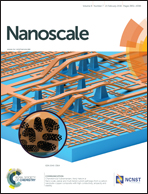One-pot synthesis and control of aqueous soluble and organic soluble carbon dots from a designable waterborne polyurethane emulsion†
Abstract
Carbon dots (CDs) have a wide range of applications and have drawn great interest in the recent decade. The fabrication and control of CDs with different solubilities are still urgent problems for their practical use. In this paper, aqueous soluble and organic soluble CDs (ACDs, OCDs) were produced by one-pot hydrothermal treatment of a designable waterborne polyurethane (WPU) emulsion. The difference in the solubility and fluorescence of these two kinds of CDs was attributed to the various functional groups on the surface, which were derived from the different segment fragments formed by hydrothermal treatment of a block polymer. It was found that the yields of the ACDs and OCDs could be regulated by means of selecting different soft segments in WPU. The more hydrophobic soft segments could result in an increase of the OCDs and a decrease of the ACDs. While the soft segments were hydrophilic or hydrolysable under hydrothermal conditions, only ACDs were obtained. The ACDs had good fluorescence and showed low cytotoxicity for use in multicolour bio-imaging. The OCDs processed good solubility in a wide range of organic solvents and were suitable for preparing fluorescent composite films with polymers.


 Please wait while we load your content...
Please wait while we load your content...